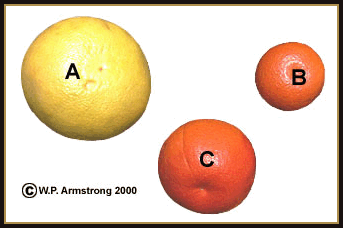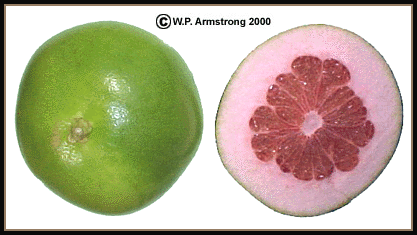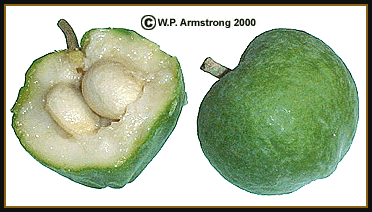|
Citrus Fruit Photos
| Economic Plant Photographs #6 |
Hesperidiums Of The Rutaceae

|
Assorted Citrus Fruits: A. and B. Eureka and Meyer's Lemons (Citrus limon); C. Tangerine or Mandarin Orange (C. reticulata = C. nobilis); D. and E. Navel and Valencia Oranges (C. sinensis); F. Tangelo (C. x tangelo). The tangelo is a hybrid produced by crossing a Tangerine (C. reticulata) with a Grapefruit (C. x paradisi). The grapefruit (C. x paradisi) is another hybrid between the Shaddock or Pomelo (C. maxima) and the Sweet Orange (C. sinensis).
|

|
Blood oranges, another variety of Citrus sinensis characterized by red pigmentation (anthocyanins) in the flesh. These oranges have been described as having a rich orange flavor with overtones of raspberries or strawberries.
|

|
A. Grapefruit (Citrus x paradisi); B. Mandarin Orange or Tangerine (C. reticulata); C: Tangelo (Citrus x tangelo). The Tangelo is a hybrid produced by crossing a Grapefruit (C. x paradisi) with a Tangerine (C. reticulata). The grapefruit (C. x paradisi) is another hybrid between the Shaddock or Pomelo (C. maxima) and the Sweet Orange (C. sinensis).
|

|
Shaddock or pomelo (Citrus maxima). These large citrus fruits are about 6 inches (15 cm) in diameter. This species is crossed with a sweet orange (C. sinensis) to produce the grapefruit (Citrus x paradisi).
|

|
A large shaddock or pomelo (Citrus maxima). These over-sized citrus fruits are about 6 inches (15 cm) in diameter. This species is crossed with a sweet orange (C. sinensis) to produce the grapefruit (Citrus x paradisi).
|

|
A large shaddock or pomelo (Citrus maxima). This over-sized citrus fruit is almost 8 inches (20 cm) in diameter. It is crossed with a sweet orange (C. sinensis) to produce the grapefruit (Citrus x paradisi).
|

|
Left: Lime (Citrus aurantiifolia), a spiny tree native to tropical Asia. There are several varieties including the small, round "bartenders lime" ('Mexican') and the larger California cultivar 'Bearss.' The 'Mexican' cultivar is also grown in the Florida keys and is the source of delicious "key lime pie." Right: Kumquat (Fortunella margarita), a citrus relative native to tropical Asia. Bigeneric hybrids between limes and kumquats are called "limequats" and are placed in the hybrid genus (x Citrofortunella).
|

|
The calamondin (x Citrofortunella microcarpa) is a hybrid fruit resembling a miniature orange. It is the result of a cross between the tangerine or Mandarin orange (Citrus reticulata) and the kumquat (Fortunella margarita). Although the flesh is quite sour, the peel is sweet. The bigeneric hybrid Citrofortunella also includes the limequat, a cross between the lime (C. aurantiifolia) and the kumquat (F. margarita).
|

|
White sapote (Casimiroa edulis), a native tree in the highlands of Mexico and Central America. Although this tree belongs to the citrus family (Rutaceae), the fleshy, very sweet fruits are not true hesperidiums as in oranges and grapefruits. They are drupelike and contain several large seeds. The delicious fruits are eaten fresh, and used for fruit salads, sauces, desserts, milkshakes and preserves. Mamey sapote (Pouteria sapota) is a widespread tropical American tree. It belongs to the sapodilla family (Sapotaceae) along with the sapodilla or naseberry tree (Manilkara zapota). It is listed incorrectly in some references as Calocarpum mammosum. In the Rio Napo region of Ecuador, the shiny black seeds are used in necklaces. Another mamey fruit called the mammee apple (Mammea americana) comes from a native Caribbean tree in the garcinia family (Guttiferae).
|
Other Members Of The Citrus Family

|
Bush Rue (Cneoridium dumosum), a native member of the citrus family in the chaparral of San Diego County. The small globose fruits and white blossoms superficially resemble miniature oranges. This shrub is also called "spice bush" because of the fragrant foliage and stems when the are crushed.
|

|
Curry leaf tree (Murraya koenigii), native to India and Ceylon. The aromatic leaves are a common ingredient in curries and chutneys. Crushed dried leaves are an ingredient in curry powder.
|
|





















